How Zoom Brought Connection at Dharma Rain
Written by: Chris Reiju Nelsen
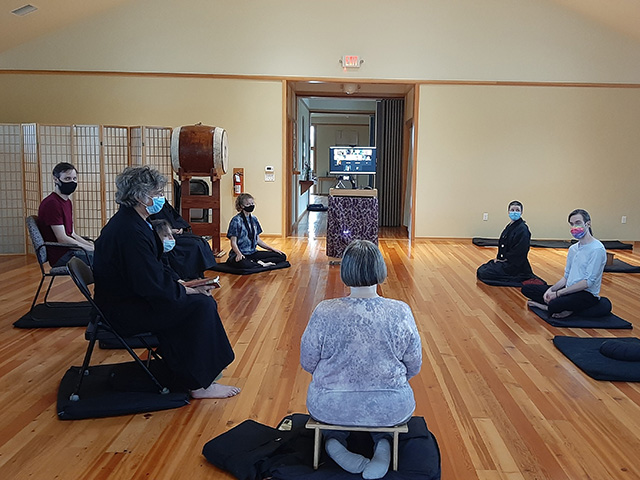
Those attending a Wednesday night Zoom class include, second from the computer screen clockwise, the newly created position of Zoom Jisha.
Photos by: Amity Irving, Chris Reiju Nelsen, Gabe Penk
During a year of intense confusion, isolation and separation, our sangha was surprised to discover forms of intimacy and fellowship, both old and new, which renewed and supported our connections despite the pandemic.
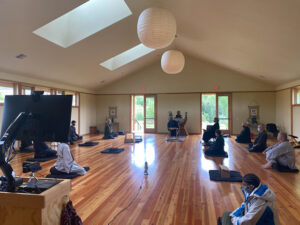
Note the masks, distance, open doors for safety, and computer and microphone for Zoom, for a May Sunday service.
Our Portland temple, Dharma Rain Zen Center, was able to stay open and offer at least some in-person programming during much of the past year. Like most places we had to shut down completely for several months at the beginning of the pandemic.
Even during the shutdown some residents remained on site, but otherwise all events happened on Zoom. But this brought an unexpected ease of intimacy, with people expressing gratitude and surprise at the closeness that arose from being able to see others practice in their own homes.
Genko Rainwater, one of our priests and the head cook, said sanzen (private meetings with a teacher about practice) had a different feel online.
“Intimacy has a lot of different facets to it and can manifest in a variety of ways. There is a great deal of intimacy and meaningful sanzen that can be had by Zoom,” Rainwater said. “When I talked to other teachers about it, we attributed it to the fact that people were in their own homes and so felt relaxed and safer.”
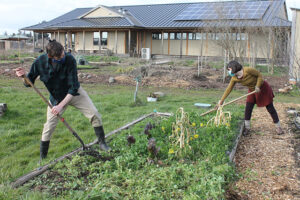
A socially distanced and masked garden work party in February. From left to right: Benjamin Bigelow and Christina Steurer.
Live streaming was a major part of our lives this year, and our temple went through a great deal of effort to make our programs accessible to people even as we had to stay at home. We went so far as to create a new service position — Zoom Jisha — to run the programming and to be the point person for all things Zoom-related.
Yuton Murrow filled that role for us, bringing unique perspective about how people experienced practice online. One major factor was figuring out how to stream the ambiance of the meditation hall.
“When audio and visual quality aren’t great, that disconnection is really felt,” Murrow said. “Not only being able to see and hear, but the quality and dynamic of the seeing and hearing make a big difference.”
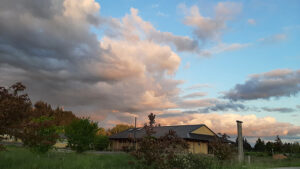
Dharma Rain Zen Center at sunset.
“For instance, having a close-up camera view of the teacher so you can see their face and their facial expressions while also being able to see the altar behind them was something that we had to figure out, because people requested it,” Murrow said. “Similarly, people wanted to be able to hear not only the teacher clearly, but also the ambiance of the area — the birds, the traffic noise, the breeze, the bells. Trying to make it so that we have both of those had been interesting.”
Although we used many new technologies to connect and find intimacy throughout the last year, some of our technologies were ancient. Genko Rainwater, in her role as head cook, was challenged by how to serve food to people, especially during retreats. She considered cafeteria style, or individual bagged meals, but ultimately turned to tradition.
“The more I thought about it, I thought, ‘Wait, this is nuts!’” Rainwater said. “We already have personalized serving bowls — oryoki sets. People know how to do service for that. I checked the state regulations, checked with Kakumyo [the abbot], who said, ‘Great, let’s do it.’ Once that was figured out, I realized we could do oryoki, which is perfect.”
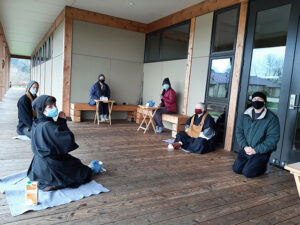
The Zen Oryoki style of eating adapted well to the restrictions of the pandemic.
Oryoki, our ritual eating practice, turned out to provide intimacy in multiple ways. Besides allowing us to eat together again (albeit outside, which was very cold all winter), it created a sense of intimacy with our ancestors. This was especially the case with our ancestor Dogen, who described oryoki in “Eihei Shingi,” the manual he wrote for his temple 800 years ago.
We found a special closeness in realizing that these forms were in part developed centuries ago to keep people from spreading disease, and that they still work to keep us safe. It was a reminder that others had been through pandemics and difficult situations, and that practice was a means of carrying them through.
Of course not all of our online experiences were connecting; many occasions had a distinctly alien feel.
Traditionally we celebrate together our ceremony of Jukai, which recognizes people who take the precepts and officially become Buddhists, as well as our ceremonies for discipleship and postulancy. Since these happened online this year, people experienced deep grief at not being able to celebrate them as usual, including those taking the vows and those who would otherwise witness the transitions.
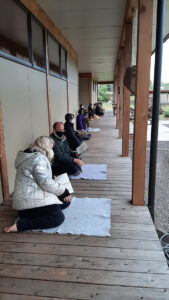
Chanting service outdoors during zazenkai, an all-day retreat in May.
Yuton Murrow, our Zoom Jisha, heard a lot of disappointment from people not able to attend in person.
“There are many senior members who have made it a point to come to Jukai to meet all of the new preceptees,” Murrow said. “This year there was a lot of frustration about not being able to see the faces or hear the voices of the new preceptees.”
She also experienced this as someone who entered postulancy this year. When she’s hosting a chat room, it’s frequent for her to get requests to show everyone the white squares sewn on her vestments that indicate postulancy.
Even in these moments of frustration, online dharma still offered new opportunities for connection. Sangha members’ families and friends could attend Dharma Rain events via Zoom from outside Oregon, sharing those special moments with many who otherwise would not attend.
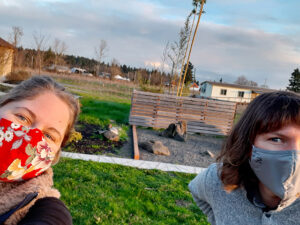
Residents enjoying some winter sunshine. From left to right Chris Reiju Nelsen and Stacy Zonnyo Riger.
As we’re continuing to re-open, we’ve had a lot of questions about whether we’ll continue to live stream all our events. One of our discoveries about intimacy has been how Zoom has made our practice more accessible. People who had moved away, aged or become infirm, people with disabilities, parents, all of them found Zoom allowed them to participate in ways impossible before.
Therefore hosting events online has become an important medium of practice in our community, and one of the things we’re grappling with is how and whether to continue to offer streamed content even as more people are able to come back in person. Now that the necessity of physical separation is ending, we have to consider whether the trade-offs of intimacy and distraction are still worth it.
We invite you to visit Dharma Rain yourself, either in person or on Zoom. Information about our schedule and links are available on our website, dharma-rain.org.
Chris Reiju Nelsen has been practicing Soto Zen at Dharma Rain Zen Center for nearly four years. In May 2020 she entered lay discipleship under her teacher, Kakumyo Lowe-Charde.
Nelsen is currently a resident at Dharma Rain and is serving as the newsletter, blog, and social media editor. She also enjoys chant leading, cooking, and taking photographs for the sangha. When not at the temple, she spends time with her godson (zenson!) and his family. In fall 2021, she will return to teaching philosophy classes at the University of Portland.
